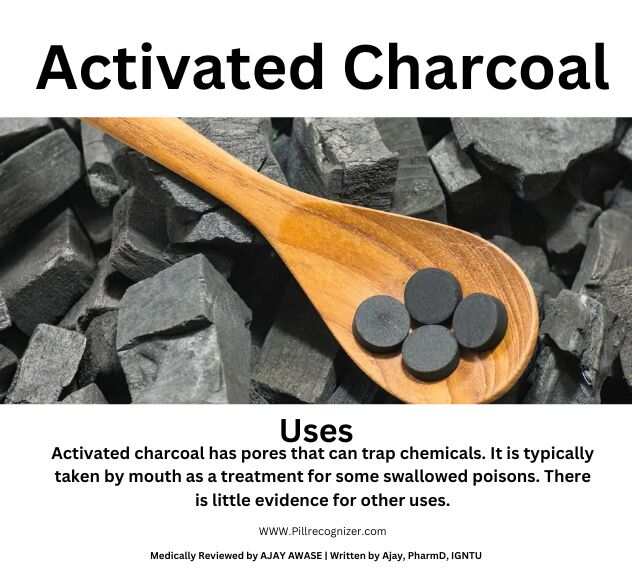Activated Charcoal – Uses, Side Effects, and More
Medically Reviewed by AJAY AWASE | Written by Ajay, PharmD, IGNTU

Overview: Activated charcoal
Chemicals can be trapped in the pores of activated charcoal. It is usually administered orally to treat certain toxins that have been consumed. There’s not much proof for other applications.
Peat, coal, wood, coconut shells, or petroleum can all be used to make charcoal. Charcoal is heated in the presence of a gas to create activated charcoal. The charcoal develops numerous interior pores as a result of this process. These holes aid in the chemical sorption of activated charcoal.
Many people use activated charcoal as a poisoning treatment. In addition, it is claimed to treat hangovers, excessive cholesterol, and upset stomachs; however, the majority of these uses lack substantial scientific backing.
Uses & Effectiveness: Activated charcoal
Potentially Beneficial for Toxins.
Activated charcoal can be taken orally to stop toxicity caused by medicines and other substances. Along with the recommended basic therapies for poisoning, it should be used under the supervision of a healthcare professional.
Many other uses of activated charcoal are being investigated, but not enough solid data is available to determine whether or not these uses might benefit from employing activated charcoal.
Side Effects: Activated charcoal
When taken orally: Short-term use of activated charcoal is probably safe. Long-term use of activated charcoal may be safe. Black stools and constipation are frequent adverse effects.
When applied topically: Most individuals can probably safely use activated charcoal on wounds.
Special Precautions and Warnings: Activated charcoal
When taken orally: Short-term use of activated charcoal is probably safe. Long-term use of activated charcoal may be safe. Black stools and constipation are frequent adverse effects.
When applied topically: Most individuals can probably safely use activated charcoal on wounds. Breastfeeding with pregnancy: Short-term usage of activated charcoal during pregnancy and lactation may be safe. Before using it, speak with your healthcare physician.
Food moving through the intestines slowly or being blocked by an obstruction in the digestive system:
If you are experiencing any form of intestinal obstruction, avoid using activated charcoal. Additionally, before taking activated charcoal, consult a healthcare provider if you have a condition that hinders the passage of food through the intestine.
Interactions:
Moderate Interaction
Use caution when combining this mixture.
Activated charcoal and alcohol (ethanol) have interactions.
When used with alcohol, activated charcoal may lessen its ability to stop the absorption of poisons.
Oral medications, or medications taken by mouth, interact with activated charcoal.
Drugs and other substances are less absorbed in the stomach and intestines when activated charcoal is used. Combining activated charcoal with oral drugs can reduce the amount of medicine that is absorbed by the body. Your medication’s effects may be lessened as a result. Take activated charcoal at least one hour after taking oral drugs to avoid this interaction.
Ipecac syrup and activated charcoal interact.
Ipecac syrup can bind to activated charcoal in the stomach. This lessens the effects of ipecac syrup.
ACTIVATED CHARCOAL interacts with birth control tablets (contraceptive medications).
The amount of chemicals absorbed in the stomach and intestines is decreased by activated charcoal. Combining birth control with activated charcoal can reduce the amount of the medication that is absorbed by the body. This may lessen birth control tablets’ effects. Use activated charcoal at least three hours after or twelve hours before birth control pills to avoid this interaction.
Dosing:
Activated charcoal is being utilized more often in cuisine as a black culinary coloring.
Activated charcoal has typically been taken orally in single doses of 100 grams under the guidance of a medical practitioner. It’s utilized in wound dressings as well. To find out what kind of product and dosage might be appropriate for a particular ailment, consult a healthcare professional.
OTHER NAME:
OTHER NAME(S): Activated Carbon, Animal Charcoal, Carbo Vegetabilis, Carbon, Carbón Activado, Charbon Actif, Charbon Activé, Charbon Animal, Charbon Médicinal, Charbon Végétal, Charbon Végétal Activé, Charcoal, Gas Black, Lamp Black, Medicinal Charcoal, Noir de Gaz, Noir de Lampe, Vegetable Carbon, Vegetable Charcoal.
Our FAQ Included This Post:


Leave a Reply